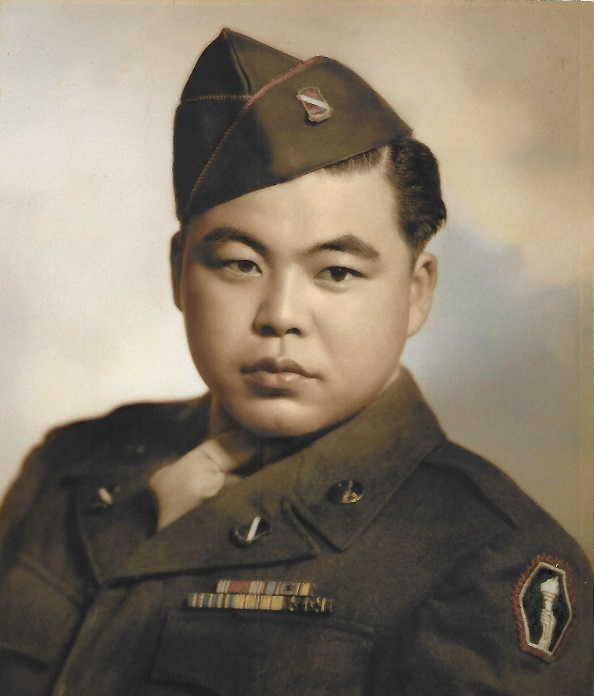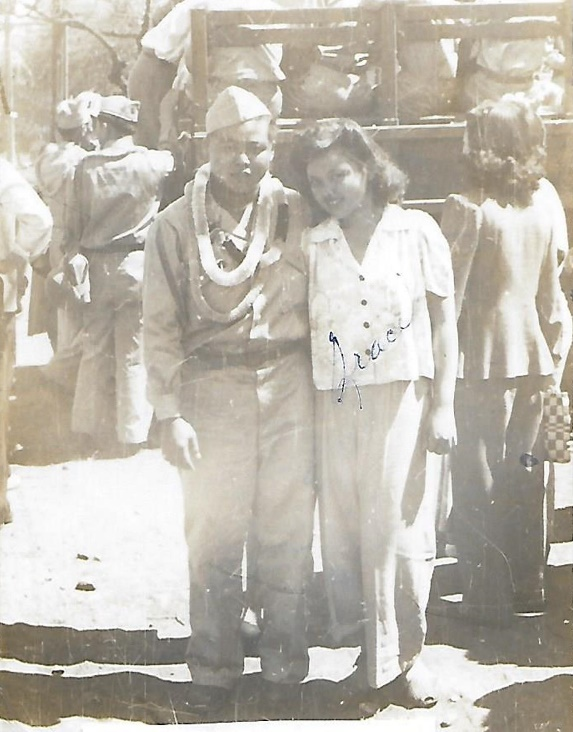
Masayoshi Yoneda
Private First Class
442nd Regimental Combat Team
522nd Field Artillery Battalion, C Battery
Masayoshi Yoneda was born on October 1, 1923, in Pearl City, Oahu, Territory of Hawaii, to Gonzuchi and Matsuyo (Mitakara) Yoneda. His father Gonzuchi arrived in Hawaii in 1913, from Yamaguchi Prefecture, Japan. His mother Matsuyo Mitakara was born in Kapapala (also known as Pahala), Kau District, Hawaii island, to Eikichi and Riyu (Kudamatsu) Mitakara. Eikichi and Ryu arrived in Hawaii in 1898 from Yamaguchi Prefecture, Japan. Masayoshi was the eldest of six children: sons Masayoshi, Shigeto, and Kozo; and daughters Kiyono, Matsuno, and Miyono.
In 1930, the family was living in Pearl City and father Gonzuchi worked for a private family as a yardman. In 1940, they were still living in Pearl City, on Ashley Avenue. Sixteen-year-old Masayoshi was employed as a boat caretaker at a yacht club.
On the morning of Sunday, December 7, 1941, he was fishing along the shore of Pearl Harbor, next to his home. When the attack began, the Japanese Zero planes were so close that he could see the faces of the pilots. Once the bombing began, Yoneda stood speechless, wondering what was going on. Then, his mother ran out of the house frantically screaming for him to get inside.
Masayoshi Yoneda (known as “Dick”) signed his Draft Registration card on June 30, 1942, Local Board No. 9, Waipahu. At the time, he was living with his family on Ashley Avenue, Peninsula, Pearl City. His point of contact was his father; he was employed by the Standard Dredging Corporation (at Hawaiian Trust Building) and working at Keehi Lagoon, Kapalama Basin. He was 5’4” tall and weighed 148 pounds.

He enlisted on March 25, 1943. His civilian occupation was construction foreman. He was sent with the other new soldiers to Boom Town, the tent city at Schofield Barracks. On March 28, the new soldiers were given a community farewell ceremony at Iolani Palace.
Right: 1943, with his sister Grace Kiyono Yoneda
Dick left Honolulu on the S.S. Lurline on May 4 with the rest of the new soldiers for San Francisco and the train ride across the US to Camp Shelby, Mississippi, for training.
While at Camp Shelby, Yoneda was assigned to C Battery of the 522nd Field Artillery Battalion of the 442nd Regimental Combat Team (RCT). After basic training, specialized training, winter maneuvers in Louisiana, then D-Series maneuvers in the DeSoto National Forest near Camp Shelby, he left with the Combat Team from Camp Shelby on April 22, 1944, by train to Camp Patrick Henry, Virginia. On May 2, they left from nearby Hampton Roads in a convoy of over 100 ships to the Mediterranean Theater of Operations. The two ships carrying the 522nd Field Artillery arrived at Brindisi and Bari on the east coast of Italy on May 28. The soldiers then loaded into boxcars and traveled by rail to their staging area in Bagnoli near Naples. There they unpacked their howitzer and weapons, re-equipping as a combat unit. Following a sea voyage by Landing Ship, Tank (LST), landing at the Anzio beachhead, and a motor convoy through the just liberated city of Rome, they joined up with the rest of the 442nd RCT and went into combat on June 26 near Suvereto.
Yoneda served in the campaigns of the 522nd – Rome-Arno in Italy, Rhineland-Vosges and Rhineland-Maritime Alps (also known as the “Champagne Campaign”) in France, and then into Germany on April 26, 1945, for the Central Europe Campaign. He was in Germany with the 522nd Field Artillery on V-E Day (May 8, 1945) and remained the rest of that year during the occupation in Donauworth.
His daughter remembers that he was the cook for his unit, a job that he loved. And he enjoyed shooting “street craps” with his Army buddies. From training camp, he sent his mother a lovely red satin throw pillow embroidered “Camp Shelby, Mississippi.”
On January 15, 1946, Yoneda was among the 432 returning veterans who arrived in Honolulu Harbor’s Pier 39-D on the USAT Mexico. Most of the men were from the 522nd Battalion. Hewassoondischarged from the Armyandabletoreturntocivilianlife.
For his military service, Masayoshi Yoneda was awarded the Good Conduct Medal, American Campaign Medal, European-African-Middle Eastern Campaign Medal with four bronze stars, WWII Victory Medal, and the Army of Occupation Medal. He was awarded the Congressional Gold Medal on October 5, 2010, along with the other veterans of the 100th/442nd Regimental Combat Team. This is the highest Congressional Civilian Medal.
Dick married Florence Akiko Yuruki and they raised a son and a daughter. He worked as a stevedore at Pearl Harbor. His daughter wrote:
He was a patient man, which showed in his favorite pastimes – fishing and growing orchids. He loved going fishing – from the shore, the pier, the breakwater. When he wasn’t fishing, he would tinker in the back yard, erecting hot houses made from green netting, to raise orchids. There were rows and rows of orchids, starting from the seedlings all the way to a full-size, blooming orchid. He had various species of orchids, but his favorite was the cattleya genus. He loved giving friends the fish that he had caught or one of his hundreds of orchids. On the weekends he would sell orchids at the nearby swap meet.
Dick also loved hanging out with his Army buddies. And when he attended the many 442nd events, he proudly wore his Go For Broke white shirt with the 442nd Torch emblem stitched on the front pocket, specially made just for the veterans.
Masayoshi’s wife Florence died in 1968, and is presently interred at the National Memorial Cemetery of the Pacific at Punchbowl. In 1980, Masayoshi moved to California and lived near Disneyland to be close to his daughter and grandchildren.
Masayoshi Yoneda died on April 23, 1989, in Garden Grove, California, and he was buried at Riverside National Cemetery in Plot 32, Site 680.
Florence Yuruki Yoneda’s older brothers also served in World War II: Robert Fujio Yuruki, M Company, 442nd Regimental Combat Team and Tadao Yuruki, 1399th Engineer Construction Battalion.
Researched and written by the Sons & Daughters of the 442nd Regimental Combat Team in 2021, with assistance from the Yoneda family.
